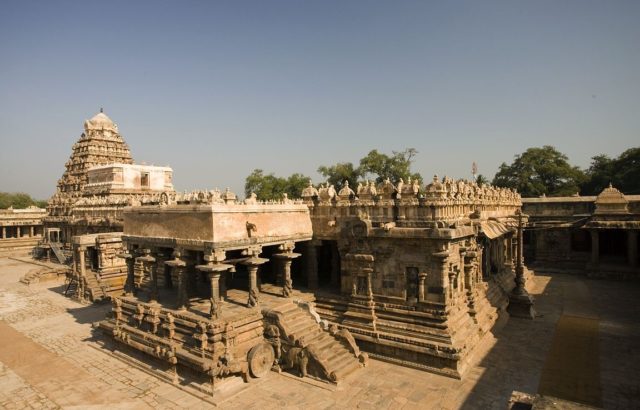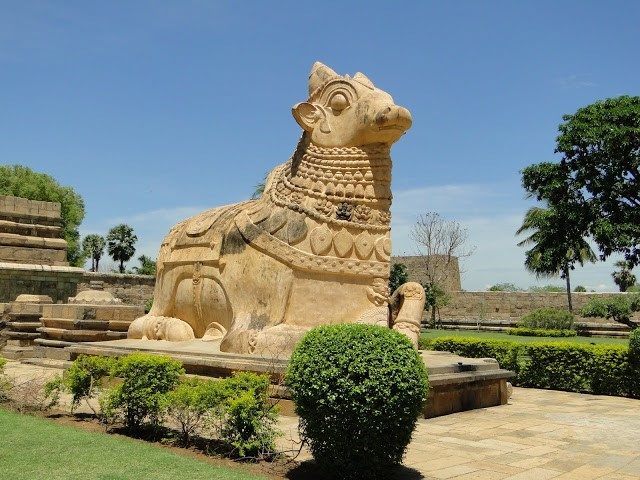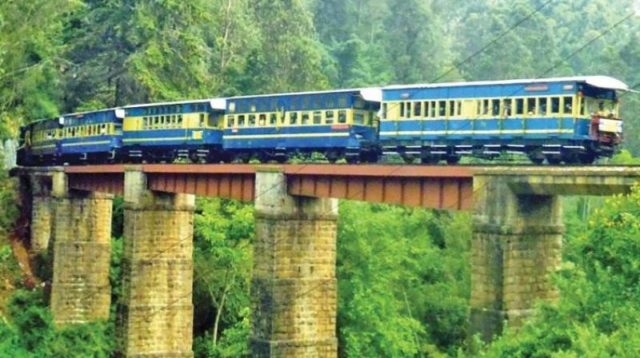PREVIOUS
UNESCO's World Heritage Sites in Tamilnadu
December 29 , 2017
2667 days
139153
0
UNESCO's World Heritage Sites in Tamilnadu
- - - - - - - - - - - - - - -
- This article "UNESCO's World heritage sites in Tamilnadu" gives you complete information about the four world heritage sites in Tamilnadu. The interesting fa cts about Two other sites namely, Western Ghats & Nilgiri mountain railway are also given in this article.
UNESCO sites in Tamilnadu
- UNESCO has a list of 29 World Heritage sites in Indiaout of which four of them are in Tamil Nadu.
- Generally, they are categorized as two groups and totally four sites are there. First three are collectively known as Great Living Chola Temples and remaining one is “Group of Monuments at Mahabalipuram.
- Besides these four sites, Western Ghats & Nilgiri mountain railway also recognized by UNESCO as Heritage site.
- Airavateswara Temple near Kumbakonam. -1987
- Brihadeeswarar Temple (Big Temple) at Thanjavur-1987
- Gangaikonda Cholapuram Temple at Jayakondam-1987
- Monuments at Mahabalipuram near Chennai-1984
GREAT LIVING CHOLA TEMPLES
- The Chola Dynasty, one of the longest ruling dynasties that ruled south India until the 13 century, is remembered for building temples with remarkable architecture among other things. Out of the many temples built during their rule, three of them stand out and today are known as the Great Living Chola Temples.
Criteria for being "Great Living Chola Temples:
- Criterion (i): The three Chola temples of Southern India represent an outstanding creative achievement in the architectural conception of the pure form of the Dravidan type of temple.
- Criterion (ii): The Brihadisvara Templeat Thanjavurbecame the first great example of the Chola temples, followed by a development of which the other two properties also bear witness.
- Criterion (iii): The three Great Chola Temples are an exceptional and the most outstanding testimony to the development of the architecture of the CholaEmpire and the Tamil civilizationin Southern India.
- Criterion (iv):The Great Chola temples at Thanjavur,at Gangaikondacholapuramand Darasuramare outstanding examples of the architecture and the representation of the Chola.
BRIHADEESWARAR TEMPLE (BIG TEMPLE) AT THANJAVUR
- Thanjavur is a place well-known for its art and architecture.
- The Brihadeeswarar Templewas recognized as UNESCO's World Heritage Site in the year 1987.
- The Big Temple or Brihadeeswarar Temple stands in the center place of Thanjavur.
- It is over 1,000 years old and has the tallest temple tower (vimanam) in the world.
- This is the world's first granite temple which portrays the temple architecture of the Cholas.
- The temple was built by RajaRaja Chola I and it took about 6 years for completion.
- The temple was name as Rajarajesvaram and the main deity Lord Shiva is known as "Peruvudaiyar".
- The temple has got a very big Nandi or the bull which weighs 25 tons.

- This temple is a very important tourist place where we can see tourists from all over the world admiring the beauty of the sculpture in the Big temple.
- It has been regarded as a ‘landmark in the evolution of building art in south India’ and its vimana as a ‘touchstone of Indian architecture as a whole’.
AIRAVATESWARA TEMPLE NEAR KUMBAKONAM
- Airavateswara Temple referred as the Great Living Chola Templeby UNESCO and was declared as the UNESCO heritage sitein the year 2004.
- This is a Hindu Saivaite temple built in the 12th century by Rajaraja Chola II.
- Airavateswara Temple is located in a place called Darasuram near Kumbakonam.
- The vimanamof the temple is 24m high. The front mandapamis in the form of a huge chariot drawn by horses. It is said the temple is said to have built with nitya-vinoda, ‘perpetual entertainment in mind’.
- This main deity of the Airavateswara templeis Lord Shiva, who is named as
- The story behind this Airavateshwara temple is Indra's white elephant "Airavata" who suffered from color change because of a curse from Durvasa Munnivar. Airvata worshipped Lord Shiva and had a bath in the temple tank which restored its color. Thus the lord was named as Airavateshwara and the temple as Airavateshwara temple.

GANGAIKONDA CHOLAPURAM TEMPLE AT JAYAKONDAM
- Gangaikonda Cholapuram, the capital of the Cholas was built by Rajendra Chola I who is the son of Great Rajaraja Chola.
- This temple was built after he captured the Ganga dynasty. This temple is built in the same way as the Brihadeeswarar Temple in Thanjavur but it is smaller than it.


MONUMENTS AT MAHABALIPURAM NEAR CHENNAI
- The Group of Monuments at Mahabalipuram, in Tamil Nadu, about 58 km from Chennai, were built by the Pallavakings in the 7th and 8th centuries.
- Mahabalipuram, also known as Mamallapuram is located about 60 km from Chennai city.
- It is one of the beautiful tourist places of South India.
- Most of these monuments are monolithic, i.e. carved out of one single rock.


- It acted as a port city of the Pallava dynastyin Tamil Nadu in the 7th century.
- Mahabalipuram's archaeological remains stands as a very good example of the Dravidian architecture.
- The monuments inscribed are the Ratha Temples: Temples in the form of chariots, Mandapas, 11 Cave sanctuaries covered with bas-reliefs, rock relief of Descent of the Ganges, which is the largest open air Rock relief also known as Arjuna's Penanceor Bhagiratha's Penance.
- Of the nine monolithic temples found in Mahabalipuram, the most important are Five Rathas known after the famous five Pandava brothers of the Mahabharata fame.
- These monuments are carved out of a single rock with choice of all known forms of plan and elevations. While the Dharmaraja, Arjuna and Draupadi rathas are square on plan, the Bhima and Ganesa rathas are rectangular and Sahadeva ratha apsidal.
- The Pallavas constructed seven granite temples called as The Seven Pagodas.
- Six temples were washed off by the sea and now only one temple remains.
- The notable cave temples here are the Varaha mandapa, Mahisamardini mandapa, Paramesvara Mahavaraha Vishnugriha (Adivaraha cave).

- The name Mamallapuram was derived from the Great Pallava King Narasimhavarman I, who was popularly called as Mamallan. Some of the important structures in Mahabalipuram are as follows:
- Thirukadalmallai
- Descent of the Ganges
- Arjuna's Penance
- Varaha Cave Temple
- The Shore Temple
- Pancha Rathas
- The influence of the sculptures of Mahabalipuram, characterized by the softness and supple mass of their modeling, spread widely (Cambodia, Annam, Java).
MOUNTAIN RAILWAYS OF INDIA
Nilgiri Mountain Railway (2005) Ooty
- The Mountain Railways of Indiarepresents a collective listing of the Darjeeling Himalayan Railway, the Nilgiri Mountain Railwayand the Kalka-Shimla Railway under the UNESCO World Heritage Site.
- However, the Mountain Railways of India are five railway lines built in the mountains of India in the 19th and early 20th centuries, during the British Raj, which are run even today by the Indian Railways.
- In 2005, UNESCOadded the Nilgiri Mountain Railway as an extension to the World Heritage Siteof Darjeeling Himalayan Railway.
- The Nilgiri Mountain Railway (NMR) is a 1,000 mm(3 ft 33⁄8 in) metre gauge railway in Tamil Nadu, India, built by the British in 1908, and is operated by the Southern Railway. NMR is the only rack railway in India The construction of NMR started in 1908.
- Initially Coonoor was the final station on the line, but in September 1908 it was extended to Fernhill, and eventually up to Udagmandalam by October 15, 1908.

WESTERN GHATS
- Western Ghats is also known as the Sahyadri Mountains.
- it is a mountain range along the western side of India.
- it is one of the world’s ten "Hottest biodiversity hotspots" (sub cluster nomination).
- A total of thirty nine properties (including national parks, wildlife sanctuaries and reserve forests) were designated as world heritage sites – twenty in the state of Kerala, ten in Karnataka, five in Tamil Naduand four in Maharashtra.
- Older than the Himalaya mountains, the mountain chain of the Western Ghats represents geomorphic features of immense importance with unique biophysical and ecological processes.
- The site’s high montane forest ecosystems influence the Indian monsoon weather pattern.
- Moderating the tropical climate of the region, the site presents one of the best examples of the monsoon system on the planet.
- It also has an exceptionally high level of biological diversity and endemism and is recognized as one of the world’s eight ‘hottest hotspots’ of biological diversity.
Five sites in TN are,
- Kalakkad Mundanthurai Tiger Reserve
- Srivilliputtur Wildlife Sanctuary
- Sathyamangalam Wildlife Sanctuary
- Chinnar Wildlife Sanctuary
- Mukurthi National Park
WAY FORWARD
These are all the UNSECO heritage sites present in Tamilnadu. Find out the Districts where they are located and read the historical Facts about the Kings who have built those structure.
**********************
Leave a Reply
Your Comment is awaiting moderation.


